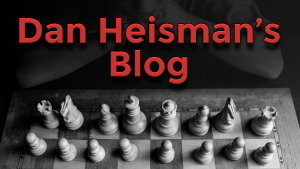At the beginning of the show I suggested that more questions that were "position oriented" could be suggested, such as how to solve puzzles, analyze positions, problems that viewers had with positions, etc. Thankfully the viewers complied, and we did include a few of these "in real time" on the show.
In two instances I was given a puzzle to solve. The first one, the viewer said was rated about 2490! That gave me pause since puzzles that difficult are not likely to be solved by me quickly, if at all, and much less in real time on a TV show. It's been a few hours since the show and I don't remember the exact position, but it was something functionally close to:
...........
So the pressure was on! I started out by saying that none of the rook checks looked very inviting. That meant the first move had to be a "quiet" move or 1.a5+, so I said let's investigate 1.a5+
Black has two replies:
So I tried to pick the one I could eliminate first, which was 1...Kb5, when I analyzed the simple 2.Rb7+ when 2...Rb6 loses and both black king moves to the a-file are mated after 3.Ra3# So far, so good.
But what about 1.a5+ Kxa5? A tougher nut to crack. Again, all the checks looked suspicious, like 2.b4+ when both of Black's legal replies looked OK, or 2.Ra3+ Kb6. Finally, a rook check by 2.R(either)c5+ Nb5 didn't look promising either. So that left a quiet move, but White has one in 2.Rb7, threatening 3.Ra3# What then?
Black can defend with a check, but 2...Nc2+ just allows a move like 3.Kd2 (when Black might survive but it did not seem likely - time was a factor since the show was "Real Time"!) and 2...f4+ was similar. Not scientifically or logically eliminated but unlikely to be the showstoppers.
The two most likely defenses to 1.a5+ Kxa5 2.Rb7 were 2...Rb6 and 2...Nb5. But after 2...Rb6 3.b4+ Ka4 4.Rxb6 wins and 2...Rb6 3.b4+ Kb5 4.Rc5+ removes the guard on the black rook on b6. Perhaps White has even better. So the main line was 2...Nb5. However, then my eye was immediately drawn to 3.Ra3+ - it's hard to explain why but these "bad-looking" lines always have to be investigated in mating nets

! The only legal reply is 3...Nxa3 but that's good - it's forcing. So then I considered 4.b4+ Ka4 5.Nc5# - the knight on a3 blocks the escape square for the king. Voila! If you don't consider moves like 3.Ra3+ because of 3...Nxa3 and stop, that's called a
quiescent error.
So, due to time constraints (the lack of time to prove that every possible line was covered, like all of Black's checks in detail after 2.Rb7), I conjectured that this must be the main line: 1.a5+ Kxa5 2.Rb7 Nb5 3.Ra3+ Nxa3 4.b4+ Ka4 5.Nc5# It felt right! Then I demonstrated the continuation on the board:
I took a little bow

.
When I got back to looking at the TV chat channel, more than one person had written "Don't just talk about it - show us the analysis on the board!"
Ah! There's the rub. If you do puzzles by moving pieces on a board, aren't you missing one of the best, and most frequent, opportunities to learn how to visualize (or imagine, as someone properly called it) positions in your head? In fact, the modern online culture that believes that a 20 minute game is a long game is always going to have visualization problems because how much analysis of lines can you do in 20 minutes for the entire game? That's only about 30 seconds per move, hardly time to see if your first candidate move is safe, much less see if multiple moves are safe and decide which one is strategically most desirable. Luckily, when I began all the tournaments and my chess club featured games with a time control of 50 moves in 2 hours (later 48 moves in 2 hours), so I often spent more than 20 minutes on one move, much less the entire game. No wonder my visualization skills were developed more quickly than some of the viewing audience. But if you are going to get a title, they currently don't give them for 20 minute games (the fastest game rated by the US Chess Federation has to be the equivalent of 30 minutes or more), so prowess in slow chess is the "title" measure, not
intermediate or blitz time controls.
You have to practice something to get better, including visualization and all other chess analysis skills. And these skills are not, as many protest, either "you have it or you don't" - you need to develop your latent talents. I wrote an
article for Chess.com on this a few months ago...
So when you are doing a puzzle like this, unless you get really frustrated, you should not move the pieces. Practice your visualization and analysis just as if you are playing a long time control game at the board.
On the other hand, ALWAYS use a board when reviewing an entire game, such as going through my book The World's Most Instructive Amateur Game Book. You learn the most by associating what the author is saying with the position on the board, and you can't associate the position on the board as well if you are trying to visualize an entire game. Visualizing an entire game may be easy for Anand or Kasparov, but I've hardly ever done it because it is difficult and I think almost everyone would learn a lot more if they can see the position being discussed right in front of them. Of course, you don't have to use a 3-D board; if you want to use a 2-D board on a computer, that's fine, too. In fact, someone asked the publisher of my book if they could get the raw game scores to put on the web so they could read it while following it electronically. Permission was granted and it was placed on Chess.com
here.
Of course, I understand there is a difference between doing the puzzle in your head and having viewers try to follow me as host while I rattle off the moves in a somewhat non-linear fashion. I realized that many could not follow my analysis until I showed the final answer on the board. But tacking the issue after the analysis did spark the discussion on the ability to develop visualization skills, and that was all good.
Luckily the other puzzle was a variation on something I had seen before, and not so difficult, although it was presented as "White to play and mate in more than one move" which was a very unusual way to pose a puzzle. Since the position had no mate in ones anyway, the way it was posed was rather moot (it was mate in 5):
We briefly discussed how I sometimes get misinterpreted as advising things like "Openings don't matter" which is patently crazy - openings are the only part of the game which you are guaranteed to play every game. They're very important.
What I do say is that which particular opening you are playing at a given time, assuming you are not a strong player and wish to improve, is not all that important, so long as you learn your opening (especially not making the same mistakes over and over - look up your opening after each game in an opening book or database), learn to follow good opening principles, and vary your openings eventually to learn different types of patterns.
Yes, it makes sense for beginners to play open, tactical positions such as those coming from 1.e4 e5. But I pointed out that even exciting openings can be played in a dull manner and very slow maneuvering openings can suddently break out into unbelievable complications, so you are almost undoubtedly going to have to deal with tactics sooner or later no matter how "avoiding of tactics" your opening choice may be, so you may as well learn to deal with that most important issue in chess, safety, by meeting it head on, and not trying to select openings which avoid it. Later, of course, when you are a strong player, which openings you choose and when, becomes more and more important.
Today's show was just for Diamond and Platinum members. On March 15 it's back to everyone as we alternate the viewing audience back and forth between these two. Hope to see you then!
 ! The only legal reply is 3...Nxa3 but that's good - it's forcing. So then I considered 4.b4+ Ka4 5.Nc5# - the knight on a3 blocks the escape square for the king. Voila! If you don't consider moves like 3.Ra3+ because of 3...Nxa3 and stop, that's called a quiescent error.
! The only legal reply is 3...Nxa3 but that's good - it's forcing. So then I considered 4.b4+ Ka4 5.Nc5# - the knight on a3 blocks the escape square for the king. Voila! If you don't consider moves like 3.Ra3+ because of 3...Nxa3 and stop, that's called a quiescent error. .
.


